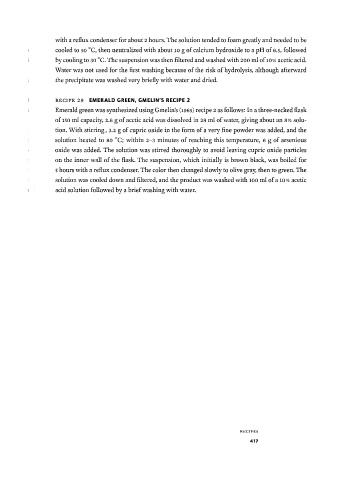Page 434 - Copper and Bronze in Art: Corrosion, Colorants, Getty Museum Conservation, By David Scott
P. 434
with a reflux condenser for about 2 hours. The solution tended to foam gready and needed to be
cooled to 50 °C, then neutralized with about 10 g of calcium hydroxide to a pH of 6.5, followed
by cooling to 30 °C. The suspension was then filtered and washed with 200 ml of 10% acetic acid.
Water was not used for the first washing because of the risk of hydrolysis, although afterward
the precipitate was washed very briefly with water and dried.
RECIPE 29 EMERALD GREEN, CMELIN'S RECIPE 2
Emerald green was synthesized using Gmelin's (i965) recipe 2 as follows: In a three-necked flask
of 150 ml capacity, 2.6 g of acetic acid was dissolved in 28 ml of water, giving about an 8% solu
tion. With stirring, 3.2 g of cupric oxide in the form of a very fine powder was added, and the
solution heated to so °C; within 2-3 minutes of reaching this temperature, 6 g of arsenious
oxide was added. The solution was stirred thoroughly to avoid leaving cupric oxide particles
on the inner wall of the flask. The suspension, which initially is brown black, was boiled for
5 hours with a reflux condenser. The color then changed slowly to olive gray, then to green. The
solution was cooled down and filtered, and the product was washed with 100 ml of a 10% acetic
acid solution followed by a brief washing with water.
R E C I P E S
417

